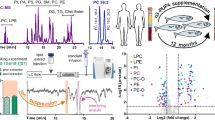Abstract
Serum analysis with LC/MS can yield thousands of potential metabolites. However, in metabolomics, biomarkers of interest will often be of low abundance, and ionization suppression from high abundance endogenous metabolites such as phospholipids may prevent the detection of these metabolites. Here a cerium-modified column and methyl-tert-butyl-ether (MTBE) liquid–liquid extraction were employed to remove phospholipids from serum in order to obtain a more comprehensive metabolite profile. XCMS, an in-house developed data analysis software platform, showed that the intensity of existing endogenous metabolites increased, and that new metabolites were observed. This application of phospholipid capture in combination with XCMS non-linear data processing has enormous potential in metabolite profiling, for biomarker detection and quantitation.






Similar content being viewed by others
References
Bennett, P. and Van Horne, K.C. (2003). Identification of the major endogenous and persistent compounds in plasma, serum and tissue that cause matrix effects with Electrospray LC/MS Techniques. Presented at the American Association of Pharmaceutical Scientists Conference, Salt Lake City, Utah
Bennett, P. and Liang, H. (2004). Overcoming matrix effects resulting from biological phospholipids through selective extractions in quantitative LC/MS/MS. Presented at the 52nd ASMS Conference on Mass Spectrometry, Nashville, TN
Creighton T.E. (1983). Proteins: Structures and Molecular Principles. W.H. Freeman, New York
Daykin C.A., Foxall P.J., Connor S.C., Lindon J.C. and Nicholson J.K. (2002). The comparison of plasma deproteinization methods for the detection of low-molecular-weight metabolites by (1)H nuclear magnetic resonance spectroscopy. Anal. Biochem. 304:220–230
Guttman A., Varoglu M. and Khandurina J. (2004). Multidimensional separations in the pharmaceutical arena. Drug Discov. Today 9(3):136–144
Janson J.-C. and Rydâen L. (1998). Protein Purification: Principles, High-resolution Methods, and Applications. Wiley, New York
Khan K., Blaak E. and Elia M.(1992). Quantifying intermediary metabolites in whole blood after a simple deproteinization step with sulfosalicylic acid. Clin. Chem. 37(5):728–733
Meng, M. and Bennett, P. (2004). A source for imprecision resulting from ionization suppression from strongly retained phospholipids and dioctyl phthalate. Presented at the 52nd ASMS Conference on Mass Spectrometry, Nashville, TN
Mills G.B. and Moolenaar W.H. (2003). The emerging role of lysophosphatidic acid in cancer. Nat. Rev. Cancer 3(8):582–591
Moolenaar W.H., van Meeteren L.A. and Giepmans B.N. (2004). The ins and outs of lysophosphatidic acid signaling. Bioessays 26(8):870–881
Phillips G.B. and Dodge J.T. (1967). Composition of phospholipids and of phospholipid fatty acids of human plasma. J. Lipid Res. 8:676–681
Polson C., Sarkar P., Incledon B., Raguvaran V. and Grant R. (2003). Optimization of protein precipitation based upon effectiveness of protein removal and ionization effect in liquid chromatography-tandem mass spectrometry. J. Chromatogr. B Analyt. Technol. Biomed. Life Sci. 785:263–275
Sasagawa T., Suzuki K., Shiota T., Kondo T. and Okita M. (1998). The significance of plasma lysophospholipids in patients with renal failure on hemodialysis. J. Nutr. Sci. Vitaminol. (Tokyo). 44(6):809–818
Shen J.X., Motyka R.J., Roach J.P. and Hayes R.N. (2005a). Minimization of ion suppression in LC-MS/MS analysis through the application of strong cation exchange solid-phase extraction (SCX-SPE). J. Pharm. Biomed. Anal. 37(2):359–367
Shen Y., Zhang R., Moore R.J. et al. (2005b). Automated 20 kpsi RPLC-MS and MS/MS with chromatographic peak capacities of 1000–1500 and capabilities in proteomics and metabolomics. Anal. Chem. 77(10):3090–3100
Sigal Y.J., McDermott M.I. and Morris A.J. (2005). Integral membrane lipid phosphatases/phosphotransferases: common structure and diverse functions. Biochem. J. 387:281–293
Siuzdak G. (2003). The Expanding Role of Mass Spectrometry in Biotechnology. San Diego, CA, MCC Press
Sivaraman T., Kumar T.K., Jayaraman G. and Yu C. (1997). The mechanism of 2,2,2-trichloroacetic acid-induced protein precipitation. J. Protein Chem. 16:291–297
Smith C.A., O’Maille G., Want E.J. et al. (2005). METLIN: a metabolite mass spectral database. Ther. Drug Monitoring 27(6):747–751
Smith C.A., Want E.J., O’Maille G. et al. (2006). XCMS: processing mass spectrometry data for metabolite profiling using nonlinear peak alignment, matching and identification. Anal. Chem. 78:779–787
Sutphen R., Xu Y., Wilbanks G.D. et al. (2004). Lysophospholipids are potential biomarkers of ovarian cancer. Cancer Epidemiol. Biomarkers Prev. 13(7):1185–1191
Vanholder R., Hoefliger N., De Smet R. and Ringoir S. (1992). Extraction of protein bound ligands from azotemic sera: comparison of 12 deproteinization methods. Kidney Int. 41:1707–1712
Van Horne, K.C. and Bennett, P. (2003). Preventing matrix effects by using new sorbents to remove phospholipids from biological samples. Presented at the American Association of Pharmaceutical Scientists Conference, Salt Lake City, Utah.
Van Horne, K.C., Meng, M., Marquardt, R. and Bennett, P. (2004). Investigation of analyte recoveries from a new sorbent designed to remove phospholipids and reduce associated matrix effects. Presented at the 52nd ASMS Conference on Mass Spectrometry, Nashville, TN.
van Oss C.J. (1989). On the mechanism of the cold ethanol precipitation method of plasma protein fractionation. J. Protein Chem. 8(5):661–668
Walter A., Korth U., Hilgert M. et al. (2004). Glycerophosphocholine is elevated in cerebrospinal fluid of Alzheimer patients. Neurobiol. Aging 25(10):1299–1303
Want E.J., O’Maille G., Smith C.A., et al. (2006). Solvent-dependent metabolite distribution, clustering and protein extraction for serum profiling with mass spectrometry. Anal. Chem. 78:743–752
Weckwerth W. (2003). Metabolomics in systems biology. Annu. Rev. Plant Biol. 54:669–689
Wilson I.D., Plumb R., Granger J. et al. (2005). HPLC-MS-based methods for the study of metabonomics. J. Chromatogr. B Analyt. Technol. Biomed. Life Sci. 817(1):67–76
Xu Y., Xiao Y.J., Zhu K. et al. (2003). Unfolding the pathophysiological role of bioactive lysophospholipids. Curr. Drug Targets Immune Endocr. Metabol. Disord. 3(1):23–32
Yang J., Xu G., Zheng Y. et al. (2005). Strategy for metabonomics research based on high-performance liquid chromatography and liquid chromatography coupled with tandem mass spectrometry. J. Chromatogr. A 1084(1–2):214–221
Acknowledgment
The authors would like to acknowledge DOE grant DE-AC02-05CH11231 and NIH SNAPS grant 5 P30 MH062261 for support of this work.
Author information
Authors and Affiliations
Corresponding author
Rights and permissions
About this article
Cite this article
Want, E.J., Smith, C.A., Qin, C. et al. Phospholipid capture combined with non-linear chromatographic correction for improved serum metabolite profiling. Metabolomics 2, 145–154 (2006). https://doi.org/10.1007/s11306-006-0028-0
Received:
Accepted:
Published:
Issue Date:
DOI: https://doi.org/10.1007/s11306-006-0028-0




